History
The church is dedicated to Saint
James, but is known as Saint Rita locally. Although there is only a chapel
here devoted to her her cult is strong. Cursed with a cruel husband,
before becoming an Augustinian nun later in life, from her canonisation in
May 1900 she became the patroness of abused wives and wronged women, with
a second film of her life released in 2004.
There had been a Romanesque church
here, the current church was built by Augustinian Hermits between in 1267
and 1315. They had originally been a community of hermits founded by the
Blessed John the Good of Modena, established near the walls of Bologna by
1247. They had founded a monastery and church dedicated to St. James the
Greater and were merged in 1256 by the papal decree with other hermit
communities into the Order of Hermits of St. Augustine. The church has
been much rebuilt, so that only the façade and side wall remain of this
original construction. In the late 15th century the interior was remade in
Renaissance style by Pietro da Brensa, and the side portico was built. By
the 16th century it had become THE church for Bologna's noble families.
The monastery was suppressed by Napoleon and in 1802 part of the complex
was taken over by the college of music later called the Conservatorio Giovanni Battista Martini, where
Rossini was once musical director. The Augustinian friars returned to part
of the complex in 1824 but were expelled again when the Kingdom of Italy
was established, keeping the church.
Façade
Topped
by a statue of the saint with a rose window and burial niches at ground
level. The very
damaged triptych of frescoes of the Virgin and Child with
Saints James the Great and Augustine over the portico entrance to the left
of the façade are by Antonio Leonelli da Crevalcore, his first known work.
The portico
Running from the left of the façade the full length of
the church, the portico was built by Giovanni II Bentivoglio between 1477
and 1481 to harmonise with the sequence taking shape around his palace.
The shell is a repeated decorative element, it being the symbol of San
Giacomo (Saint James).
Interior
An
aisleless nave, the chapels are toppeed with a terracotta frieze on which
are statues of Christ and the Apostles and urns, added in 1727. This is a
church of much fresco fascination, both complete and in tantalising
patches. The best stuff is in the ambulatory chapels.
The less-interesting nave has 17th and 18th
century works, mostly, in nine chapels on each side, all frescoed on their
side walls. Each group of three chapels has a ledge with statues of two
saints above and a window, real or trompe l'oeil, behind (see photo
below right).
The second chapel on
the left side has a fine Cena del Signore by Federico Barocci. The
fourth on the right is made much
of and is dedicated to Saint Rita. In the fifth chapel on the right is a large
altarpiece of The Virgin and Saints (8) of 1565 by Bartolomeo
Passarotti, with a strange naked smiling and pointing figure front centre, in a frame by the workshop of Formigine (and a
scagliola altar frontal
dating from 1674) In the ninth chapel is a dark painting of Saint Roch by
Ludovico Carracci. The largest chapel on the right side, making a sort
of transept arm at the entrance to the ambulatory, has Mannerist
frescoes by Pellegrino Tibaldi of 1555. The altarpiece here is a Baptism of
similar date by Prospero Fontana.
The facing last chapel before the ambulatory, on the north side, has a
very Mannerist (in colour and vigour) Martyrdom of Saint Catherine by Tiburzio Passarotti (1577), and in the chapel to
its left is a Virgin in
Glory with Saint Nicholas and the Three Daughters by Bartolomeo Cesi.
 On the
high altar is a polyptych of the Coronation of the
Virgin and Saints by Jacopo di Paolo of c.1420. Above hangs a large painted Crucifix, also by him. The
huge altarpiece of The Resurrection on the east wall of
the apse behind, in the very chunky
gilt frame under the scalloped apse, is by Tommaso Laureti (1574). On the
high altar is a polyptych of the Coronation of the
Virgin and Saints by Jacopo di Paolo of c.1420. Above hangs a large painted Crucifix, also by him. The
huge altarpiece of The Resurrection on the east wall of
the apse behind, in the very chunky
gilt frame under the scalloped apse, is by Tommaso Laureti (1574).
The sequence of highlights in the ambulatory chapels begin, from the right,
in the second chapel with its fine polyptych by
Paolo Veneziano, dating from c.1350, commissioned by a private patron as
the high altarpiece. It has 21 panels painted in tempera, of varying sizes,
featuring
Saints Martin and George on horseback, top right and top left, and three scenes from the life of Saint
Nicholas of Tolentino in the predella's centre, below a cross-shaped reliquary
space where
there may once have been another painting. The damaged detached frescoes
in here (and on the wall of the ambulatory behind you, to the right) of the Life of Saint Mary of Egypt
by Cristoforo da Bologna also date from the late 14th century.
In the third chapel (see photo left) is a Crucifix signed and dated 1370 by Simone dei
Crocifissi, commissioned by a private patron for the tramezzo. There's a studio of Guercini Saint Jerome
behind the altar in this
chapel too, as well as another polyptych, of The Coronation of the
Virgin with Saints, by Jacopo di Paolo, painted
around the same time as his high altarpiece. (The latter was not to be
seen in May 2024 but was still mentioned on the sign.)
The
Bentivoglio Chapel
The Cappella Bentivoglio (see
photo right) ends the sequence of chapels in the right wing. It has a coin-operated light, but the
gate is kept closed, except on Saturday mornings from 9.30 to 12. 30,
thanks to the Touring Club of Italy. It was
built in 1451 for condottiere Annibale I Bentivoglio, who had become Lord
of Bologna after wresting rule from Milanese condottieri in 1443. His
reign was short, lasting until his assassination in 1445. His 1458
memorial is in here. The chapel was enlarged in 1486 by Giovanni II Bentivoglio, who
himself ruled from 1463. He made the chapel a dynastic mausoleum and used
it for civic rituals, like the conferring of knighthoods and the
appointment of university professors. Giovanni ruled until 1506, when the Bentivoglio were ousted by Pope Julius II who wanted
to reclaim Bologna for the Papal States and found willing allies in the
members of the other noble families of Bologna keen to grab the power
and properties that the Bentivoglio had hoarded.
The chapel has a domed centrally-planned design, supposedly inspired by Brunelleschi
but much more decorated - the architect was Pagno di Lapo Portigiani. It has
decorations dating from the 1480s and 90s. There's a c.1494 single panel Sacra
Conversazione
altarpiece by Francesco Francia, The Virgin and Child with
Angels, Saints Proculus, Augustine ,
John the Evangelist, and Sebastian called the Pala Bentivoglio (see
below right). The two figures kneeling either side of the Virgin are
said to be two of Giovanni's children. But the chapel's famous frescoes
are earlier and by Francia's
friend and frequent
collaborator Lorenzo Costa. On the left wall he painted
The Apocalypse (in the lunette) and The Triumph of Fame and
Death (both 1490) in the panel below. The earlier one on the right wall
looks a little flat and shows The Virgin Enthroned with Giovanni II Bentivoglio
and his wife Ginevra from 1488, also featuring their 11 children. The
wife is said to have been cruel and violent and the children were doomed
to soon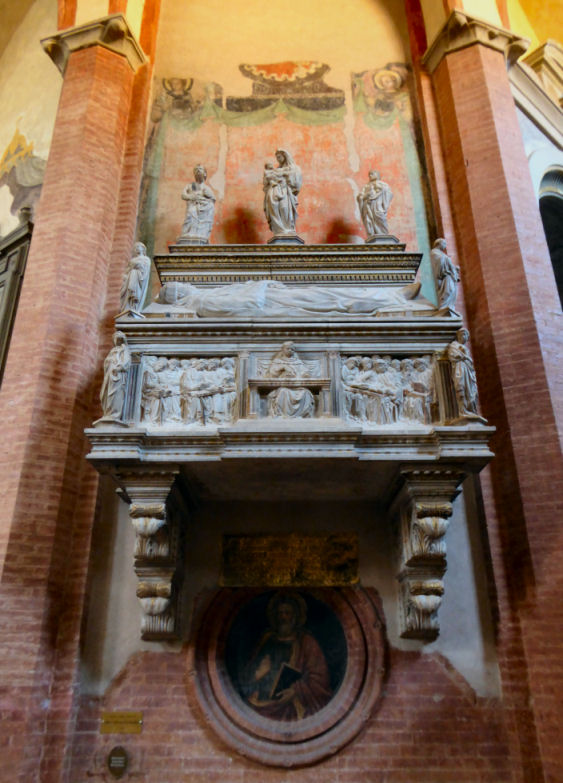 suffer from their family's downfall, and a couple would become
cruel and murderous too. The exception is Camilla the daughter in a
nun's habit who took the veil at Corpus Domini in Ferrara, where her
sister Isotta joined her later. The relief of Annibale on
horseback dating from 1458 and attributed to Niccolò dell'Arca, was inserted to the right into a previous
landscape fresco. There are three more frescoed lunettes on the walls above by a
pupil of Costa. The left one has lost its middle third... The Annunciation
in? by? suffer from their family's downfall, and a couple would become
cruel and murderous too. The exception is Camilla the daughter in a
nun's habit who took the veil at Corpus Domini in Ferrara, where her
sister Isotta joined her later. The relief of Annibale on
horseback dating from 1458 and attributed to Niccolò dell'Arca, was inserted to the right into a previous
landscape fresco. There are three more frescoed lunettes on the walls above by a
pupil of Costa. The left one has lost its middle third... The Annunciation
in? by?
The original, and very worn, majolica floor tiles remain,
are credited to the della Robbia workshop (1498)
and are to be admired.
Against the sanctuary wall, opposite the chapel entrance, is the tomb of Antonio Galeazzo Bentivoglio, Annibale’s father,
who had been interred originally in the church of San Cristoforo del
Ballatoia, but whose remains where brought here after Annibale's purchase
of the chapel opposite.
It has a panel showing him sitting at his
desk surrounded by pupils below his effigy (see photo right). This is one of the last works of
Jacopo della Quercia, and assistants from 1435.
The Poggi Chapel nearby has a Baptism of Christ by Prospero Fontana
from 1561 and a very decorated vault.
Another nearby
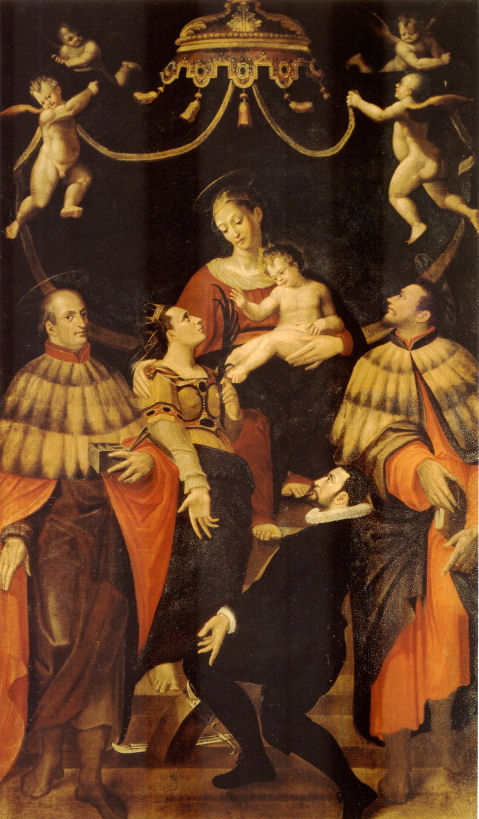 chapel (the Calcina)
has an Virgin
and Child with Saints Catherine of Alexandria, Cosmas and Damian and a
Donor (1589) by
Lavinia Fontana (see right). The donor being Scipione Calcina, a banker,
from a family of doctors, who
commissioned the work as part of his strategy to ingratiate himself back into Bolognese society
and demonstrate his commitment to his strategic new wife, named Catherine. He needed
to marry and ingratiate after having been fined massively and banished
from Bologna for the crime of sodomy, and where better to show this than
in the church patronised by the greatest number of bologna's noble
families. The Calcina chapel had been built and dedicated to Saints
Cosmas and Damian in 1408 by a Calcina ancestor, and the altarpiece
features the pair wearing ermine robes, with Calcina kneeling in front
appealing to Saint Catherine, his new wife's name saint. chapel (the Calcina)
has an Virgin
and Child with Saints Catherine of Alexandria, Cosmas and Damian and a
Donor (1589) by
Lavinia Fontana (see right). The donor being Scipione Calcina, a banker,
from a family of doctors, who
commissioned the work as part of his strategy to ingratiate himself back into Bolognese society
and demonstrate his commitment to his strategic new wife, named Catherine. He needed
to marry and ingratiate after having been fined massively and banished
from Bologna for the crime of sodomy, and where better to show this than
in the church patronised by the greatest number of bologna's noble
families. The Calcina chapel had been built and dedicated to Saints
Cosmas and Damian in 1408 by a Calcina ancestor, and the altarpiece
features the pair wearing ermine robes, with Calcina kneeling in front
appealing to Saint Catherine, his new wife's name saint.
Lost art in the Pinacoteca
A large fresco panel of Saint
James at the Battle of Clavijo (c.1315/1320) by the Pseudo-Jacopino. This
mythical battle happened sometime in the mid-9th century. Saint James is
said to have appeared, 800 years after his death, and lead the Spanish
Christians to defeat the Muslims.
A fresco panel of the
Virgin and Child Enthroned with Saints James and John the Baptist
by Jacopo da Bologna (c.1350/60).
Two panel fragments from a polyptych (centred on The
Coronation of the Virgin) by Lorenzo Veneziano,
showing Saints Anthony Abbot and Bartholomew (1368)
from the monastery here.
A pair of panels showing Saints Bartholomew and
Peter by Jacopo di Paolo.
A tondo of Man of Sorrows by Francia, from the Bentivoglio
Altarpiece in the Bentivoglio chapel
here.
Lost art
elsewhere
The early-14th- century Istrian stone
tomb of Bonandrea de' Bonandrei is now in the Medieval Museum.
Two panels, depicting Saints Anthony Abbot and Dominic, by
Giovanni da Modena from c.1445/50, may be from an altarpiece painted for
this church. Four more panels are in Santo Stefano.
The church in art
Portico of Via S. Donato and Facade of San Giacomo Maggiore by Antonio Basoli (see
right).
Opening times
Monday to Friday - 7.30 - 12.30 and 3.30 - 6.30
Saturday, Sunday and holidays - 8.30 am - 12.30 am and 3.00 - 6.30 pm.
On Saturday mornings the Touring Club of Italy opens the Bentivoglio
Chapel from 9.30 to 12.30.
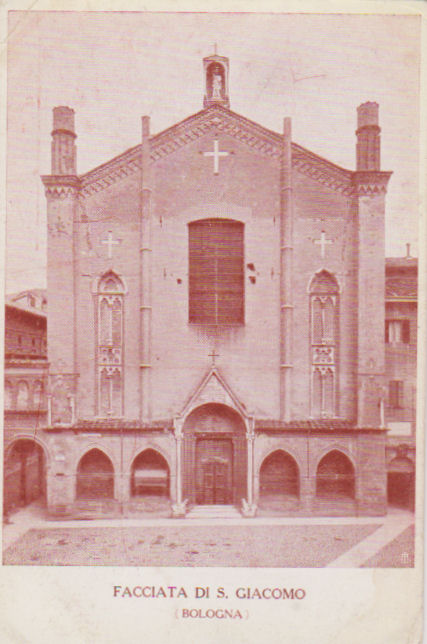 |
|
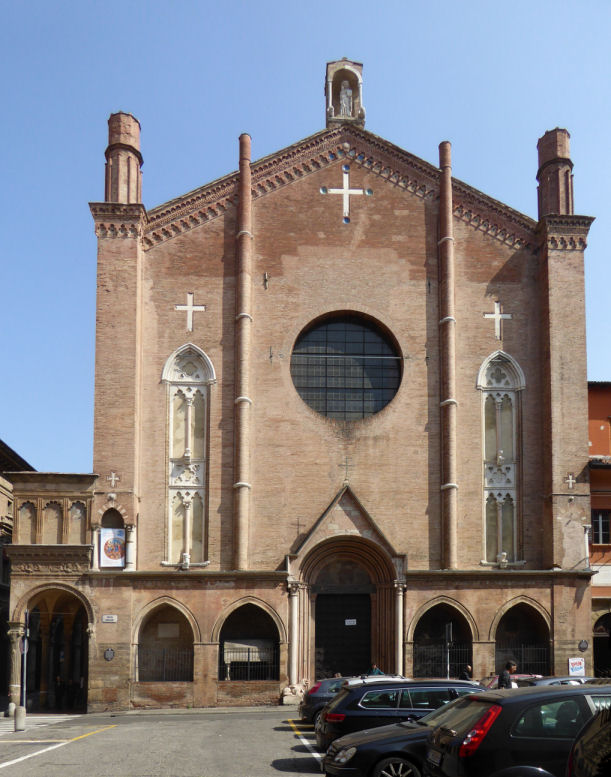

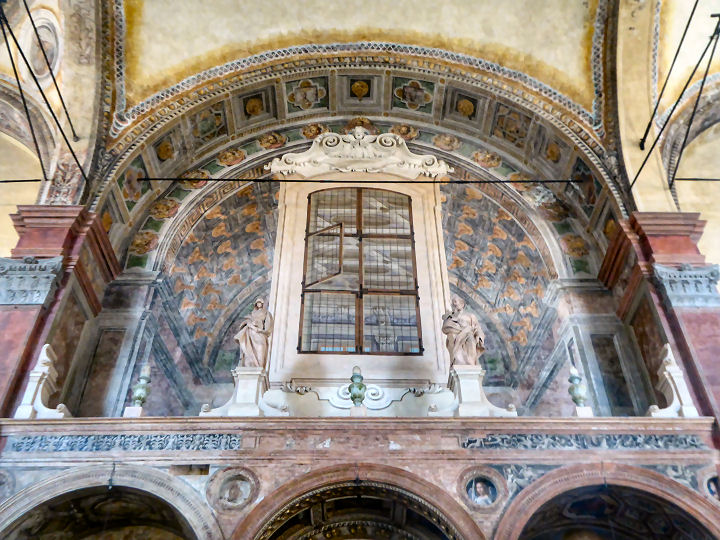

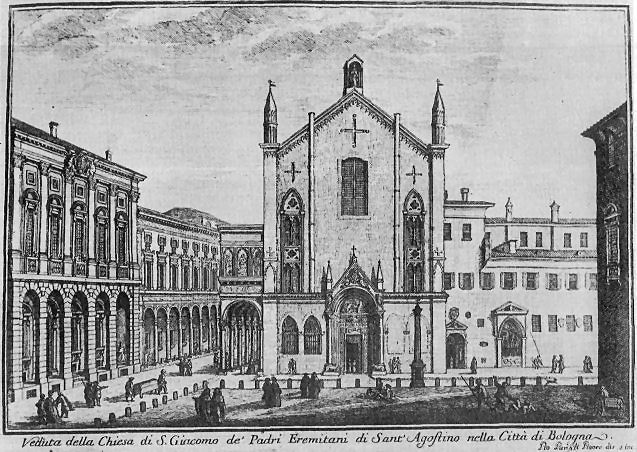
An 18th-century print, before the
circular window was reinstalled.
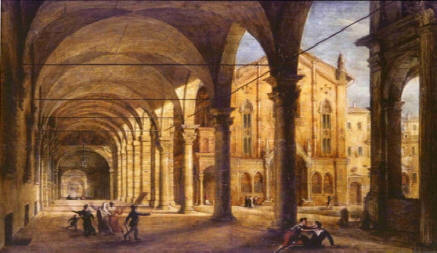
Santa Cecilia
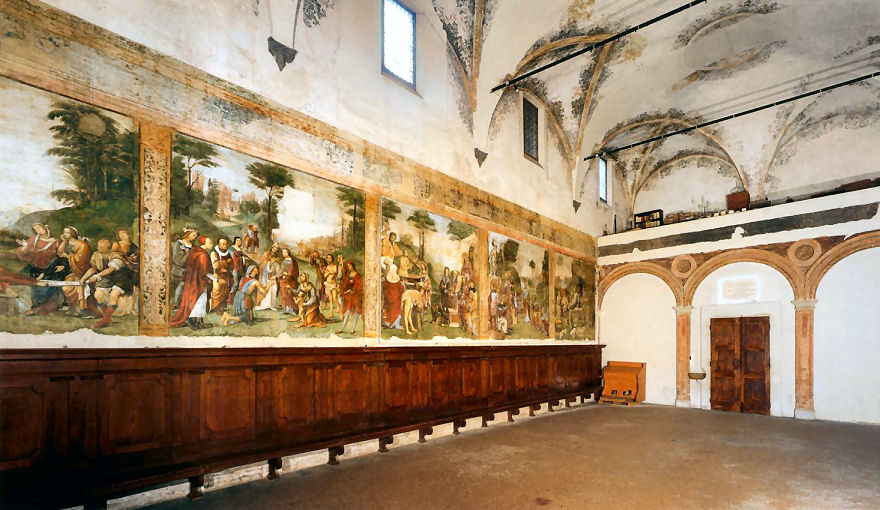 A
A photo which I've 'borrowed', taken before the
installation of the cash desk and gift shop. A
A photo which I've 'borrowed', taken before the
installation of the cash desk and gift shop.
Leaving San Giacomo Maggiore and turning right takes you along a Renaissance
portico, added in 1478-1481 by Giovanni II Bentivoglio and now blighted with
graffiti, to the former church of Santa Cecilia.
History
The early history of this church is
vaguely documented. We know that in 1323 it passed from the order of the
Santuccia Terrabotti to the monks of San Giacomo Maggiore, who
rebuilt in 1359. And so it remained until suppression in 1805. Used for
concerts now, especially from March to June during the San Giacomo Festival.
Interior
Frescoed for
Giovanni II Bentivoglio from 1504 to 1506 by Francesco Francia, Lorenzo Costa and their
pupils, including Amico Aspertini, with ten scenes from the life of the
virgin martyr Saint Cecilia, all recently restored.
Starting to the left of the altar they show...
1. her (forced) marriage to the pagan Valerian (Francia)
2. the conversion of
Valerian by Pope Urban I (Costa)
3. the baptism of Valerian by Urban (attrib. to Chiodarolo and Tamaroccio)
4. an angel crowning Cecilia and Valerian (Costa and studio)
5. the martyrdom of Valerian
and his brother Tiburtius (Aspertini)
6. their burial (back end of the right wall) (Aspertini)
7. the trial of Cecilia
in which she is condemned to death (Bagnacavallo and Biagio Pupini)
8. the (attempted) martyrdom of Cecilia (Chiodarolo and Tamaroccio)
9. Cecilia dispensing charity (she took three days to die) (Costa)
10. the burial of
Cecilia (with her head) (Francia).
The altarpiece of The Crucifixion with The Virgin, and Saints
Francis, Mary Magdalene, Saint Honofrius(?)Jerome , and John the
Evangelist is by Francia. The narthex area is also frescoed, and leads
into
some sweet little cloister areas with more odd fresco patches.
|